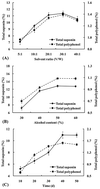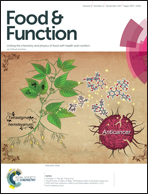The development of a Panax notoginseng medicinal liquor processing technology using the response surface method and a study of its antioxidant activity and its effects on mouse melanoma B16 cells
Abstract
Panax notoginseng medicinal liquor (PML) has a long history of use in the function of blood circulation. However, the processing of PML is currently dependent on experience, which results in low efficiency and unstable quality of PML. A variety of substances of P. notoginseng have a strong ability to scavenge free radicals and antioxidant activity, but the antioxidant activity of PML has not been formally researched. The aim of the present study was to optimize the processing technology of PML and to verify the anti-oxidation and anti-deposition of melanin functions of PML. Based on the Box–Behnken design of response surface method, the PML processing parameters were established as follows: the ratio of liquid to solid 32 : 1, 53% of alcohol, and soaking time of 35 d. With elevating concentration of PML extract, the reducing force and scavenging rates of DPPH, superoxide anion, hydroxyl radical and ABTS+ were increased, and the inhibition rate of tyrosinase activity and the melanin synthesis ability were increased in mice melanoma B16 cells. Thus, the optimal processing technology not only shortened the processing time but also decreased the material costs. PML may be developed as food or beauty products for the functions of anti-oxidation and anti-deposition of melanin.



 Please wait while we load your content...
Please wait while we load your content...